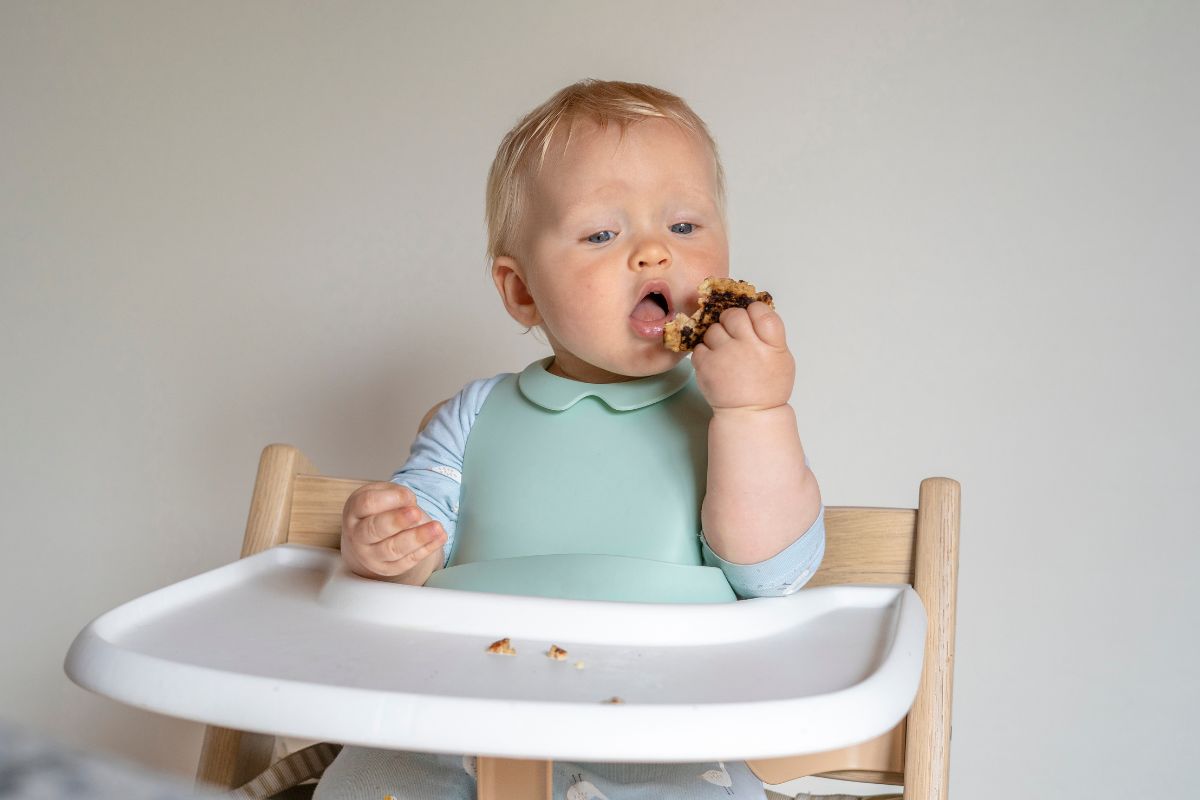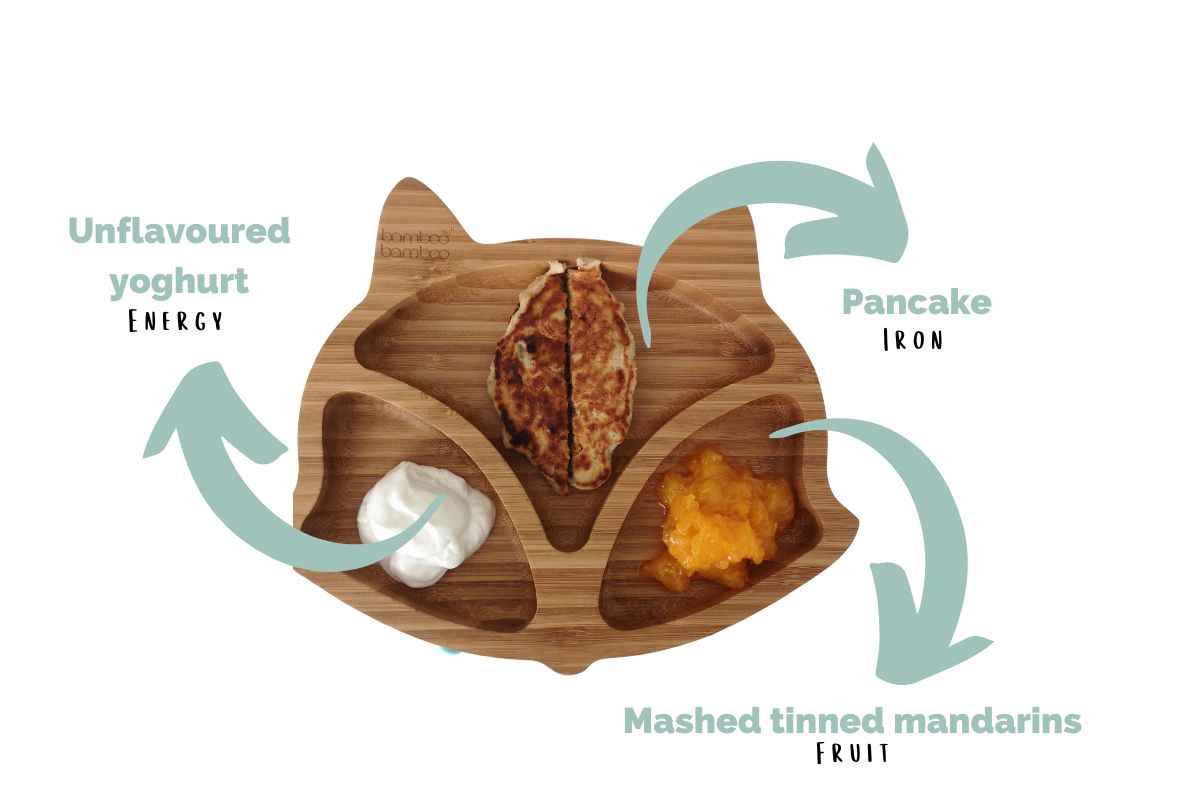Portion sizes for babies aren’t about strict measurements. This guide shows you how to trust your baby’s hunger cues while offering balanced meals that suit their appetite.
If you’ve ever found yourself staring at the spoon, wondering if that last bite was enough—or too much—you’re not alone.
One of my clients, Aoife, felt the same way when she started weaning her baby. Armed with baby cookbooks and advice from every corner of the internet, she precisely measured out spoonfuls.
But when her baby pushed the food away after just a few bites, the doubt crept in. Should she offer more? Was her baby still hungry, or just distracted?
Weaning can feel overwhelming when you’re focused on portions, but here’s the good news: it’s not about strict measurements. It’s about trusting your baby to guide you, and I’m here to help you feel confident doing just that.
Bonus: As a bonus for joining my weekly newsletter, get this free cheat sheet, ‘Weaning at a Glance’.

It’s clear this baby wants more food!
Feed to Appetite, Not to Portion Size: Trust Your Baby’s Cues
Research shows that responsive feeding is the best approach to feeding your baby from birth.
If you’ve been breastfeeding, you’re likely already familiar with this—you know that your baby can take in just the right amount of milk on their own. And many of you bottle-feeding are probably using responsive techniques too.
The same rule applies to food. Your job is to offer balanced meals, but it’s your baby’s job to decide how much to eat. Responsive feeding not only supports their natural appetite regulation, but it’s also a skill that will benefit them well into adulthood, especially in a world full of food choices.
READ MORE: A Complete Guide to your baby’s weaning journey
Responsive Feeding-and not strict portion sizes
Responsive feeding is all about letting your baby decide how much they want to eat at each meal—without the pressure to hit some made-up portion goal.
So, no ‘here comes the aeroplane‘, no ‘choo choo spoons‘, and definitely no sneaking bites in while your baby is distracted by screens or toys. Your little one needs to be actively involved in eating, not just a passive bystander!

STOP: no, here comes the aeroplane.
How to spoonfeed responsively
One of the most reassuring ways to approach feeding is through responsive feeding. This means paying attention to your baby’s hunger and fullness cues and letting them decide how much to eat. Babies have natural hunger cues that signal when they are ready to eat and when they are full.
Here are some signs to watch for:
Your baby is saying “I’m hungry” when they:
- Fuss
- Get excited to see the food.
- Reach for the food or spoon
- Open their mouth
- Lean towards you and the food
Your baby is saying “I’m full” when they:
- Turn their head away.
- Spit out the food (although they can do this for other reasons too!)
- Push away the food or spoon
- Close their mouth or cover it with their hands
- Get distracted
- Fall asleep!
By following your baby’s cues, you can avoid overfeeding or worrying about exact portion sizes. Trust that your baby will eat what they need.

Why Your Baby’s Appetite Changes Day to Day
Just like adults, babies’ appetites fluctuate. One day, they might polish off everything you offer, and the next day, they’ll hardly eat. This can feel confusing, but it’s completely normal. A few reasons for these changes include:
- Growth spurts: Babies go through periods of rapid growth where they need more energy.
- Teething: When a baby is teething, they might eat less due to discomfort.
- Illness or fatigue: If your baby feels under the weather or extra tired, they may not be as hungry.
These are just a few examples, but remember—just because your baby eats less on some days doesn’t mean they aren’t getting enough.
READ MORE: 7 secrets to understanding why your two-year-old isn’t eating well
How Much Should I Offer? Portion Sizes as a Starting Point
While portion sizes for babies aren’t strict, it helps to have a rough idea of what to offer. Here’s are some simple guidelines:
- Use age-appropriate bowls and plates.
- Offer 1-2 pieces of finger food and 1-2 tablespoons of each mashed food. Offer more if your baby is showing signs that they want more. Offering large portions at mealtimes can either overwhelm your baby or lead them to eat more than they need. You’ll start to get a sense of how much your baby generally eats as you go along. Don’t worry if you sometimes have food leftover or if some days you run short. Your baby will have the chance to regulate at the next meal or milk feed.
- Remember your baby’s appetite will vary from meal to meal and from day-to-day.
These are starting points. Some babies will eat more, others less, and that’s okay. What’s important is creating a relaxed environment where your baby can explore new foods without pressure.

This is a starter portion, offer more if and when your baby wants more of any food
What if My Baby Seems to Eat Too Much?
It’s easier for babies to eat pureed or mashed foods when spoon-fed by a parent than feeding themselves.
Here’s how to manage portion sizes for babies while helping them learn to self-regulate:
- Spoon-feed responsively. Ensure your baby opens their mouth before offering the spoon, and wait for them to take the food off it. Avoid placing the food directly into their mouth.
- Include finger foods with spoon feeds. Finger foods not only let your baby explore whole foods and develop self-feeding skills, but they also help pace the meal, giving your baby time to recognize when they’re full.
- Check the texture of spoon-fed foods. Don’t stick to smooth, easy purees. By around seven months, your baby should be able to handle mashed foods with soft lumps and, by ten months, finely chopped food from a spoon.
READ MORE: How to offer finger foods to babies: A step-by-step guide

Self-feeding (and responsive spoon-feeding) helps babies to regulate how much they eat
What if My Baby Refuses to Eat?
Learning to eat is just like learning to walk or talk—it takes time, and every baby is different. Some babies dive right into food, while others need more time.
Even after your baby gets used to eating, there will still be days when they eat less or refuse food altogether. That’s completely normal. The key is to stay calm and avoid pressuring your baby to eat, as this can lead to anxiety, food refusal, or even overeating down the line.
Remember, it’s about trusting your baby’s pace.
READ MORE: Worried about constipation and weaning? 6 easy ways to keep things moving!
How Do I Know If My Baby Is Eating Enough?
The easiest way to tell if your baby is getting the right amount of food is by keeping an eye on their growth. Your Public Health Nurse (PHN) will track this during developmental checks, or you can ask your GP or practice nurse to monitor it.
It’s perfectly normal for babies to move slightly between centile lines on their growth chart, so don’t worry if there’s a little variation.

Watch Out for Comfort Feeding
A key part of responsive feeding is offering food when your baby is hungry—not as a way to comfort, distract, or manage their behaviour. As a parent, I completely understand how tempting it is to use food to calm your baby—I’ve done it myself! But while it may work in the moment, it can lead to challenges down the road.
This is where the Division of Responsibility in Feeding comes in: your role is to decide what, when, and where to offer food, and your baby’s role is to decide how much to eat, or even if they want to eat. At this stage—between 7 and 12 months—solids are typically offered at three meals a day to encourage structured eating. This helps your baby recognize when it’s time to eat and prevents the habit of using food outside of mealtimes for comfort.
However, using breastfeeding for comfort is perfectly fine and a great way to soothe your baby. When you stick to this balanced approach, you help your baby develop a healthy relationship with food that supports their growth and emotional well-being.
How to Balance Meals Without Worrying About Portions
Instead of stressing about portion sizes, focus on offering balanced meals. This approach ensures your baby is getting the nutrients they need, without worrying if they’ve eaten “enough.”
Here’s a simple way to balance each meal:
- Iron-rich food: Lentils, chicken, tofu, or iron-fortified cereals.
- Energy-rich food: Sweet potatoes, pasta, or whole grains.
- Fruit or vegetable: Steamed carrots, avocado, or apples.
By offering a mix of these food groups at each meal, you can feel confident that your baby is getting what they need, regardless of how much they eat.
NEED INSPO? The Tricky Third Meal-Quick and Easy Baby Lunch Ideas

Why Portion Sizes Don’t Make Sense for babies (or anyone else!)
You’ll often see ‘weaning experts’ online suggesting exact gram amounts to serve at each meal—but this doesn’t make sense! For example, 60g of chicken casserole is very different nutritionally from 60g of apple puree. Babies’ needs vary, and focusing on exact measurements misses the bigger picture of balanced, nutritious meals.
Common Myths About Portion Sizes for Babies
There’s a lot of information out there, and sometimes it’s hard to know what’s accurate. Here are a few myths about portion sizes for babies—and the facts that debunk them:
Myth 1: Babies need to finish everything on their plate. Fact: Babies naturally regulate their intake. Forcing them to eat more than they want can lead to unhealthy eating habits in the future.
Myth 2: If my baby refuses a meal, they’ll be hungry. Fact: It’s okay if your baby skips a meal. Offer them something at the next regular mealtime, and don’t worry—babies will make up for it when they’re hungry.
Myth 3: Bigger portions mean better nutrition. Fact: Offering too much food can be overwhelming for babies. Small portions allow them to explore food at their own pace.
Final Thoughts: It’s Not About Perfection
Weaning can be a challenging phase, especially when it comes to figuring out portion sizes for babies. But remember, it’s not about perfection—it’s about creating a positive experience with food. Trust your baby to guide you. Some days will be messier than others, and that’s part of the process.
If you’re looking for more support or personalized advice on weaning, my Ready Steady Wean course covers everything you need to know—from portion sizes to introducing allergens. You don’t have to do this alone, and with a little guidance, you can enjoy the journey of introducing your baby to a world of flavours.
Or If you’d like tailored advice or need help navigating the weaning process, book a one-to-one consultation with me. Together, we can create a plan that works for your baby and your family.
Get Your Free Cheat Sheet
When you’re bamboozled by weaning just take a moment! This cheatsheet will help you stay on track during weaning.
- Get the free cheat sheet. You’ll get the cheatsheet, plus join my weekly newsletter! Just click here to get it and subscribe.
- Print or download onto your phone.
- Hang your cheat sheet somewhere handy, like the fridge. Or save it in a folder on your phone.
Ready, Steady, Wean-From Confused To Confident In No Time At All
Save yourself time, stress and money and get all the answers you need in one easy-to-follow online course.

Signs your baby is ready for weaning: 3 easy things to watch out for
Everyone has an opinion on when your baby should start eating solids. But forget about your mother-in-law! And let’s dig into the answers with up-to-date evidence and also bust some myths about signs your baby is ready for weaning.
Easy ways to serve Weetabix for babies-and why to do it!
There’s no shortage of fancy baby breakfast ideas around. But why not keep it simple? This blog shows you how to serve Weetabix for babies and why to feel good while you do it!
Worried about constipation and weaning? 6 easy ways to keep things moving!
INSIDE: Is your baby struggling to poo? Or have you heard that constipation can be a problem during weaning? Don't worry, by the time you've finished reading this blog; you'll have the FULL lowdown on what to expect in your baby's nappy when they start solids (and how...










0 Comments